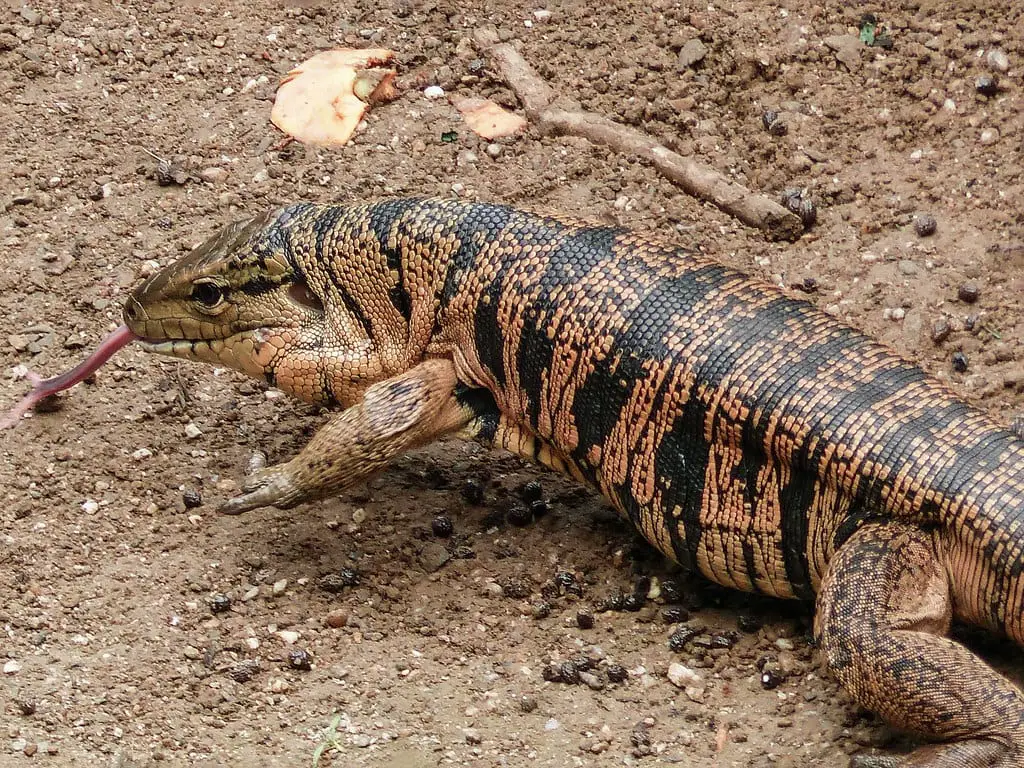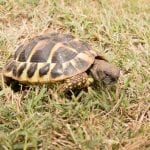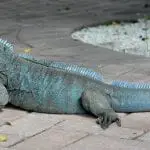Scientific Facts
| Common Name | Gold Tegu |
| Scientific Name | Tupinambis teguixin |
| Captive Lifespan | 12 to 20 Years |
| Size | 2 – 3 ½ feet |
| Mass | 3.5 – 4.0 kilograms |
| Habitat | Tropical habitat |
| Country of Origin | Central and northern South America |
Physical Description
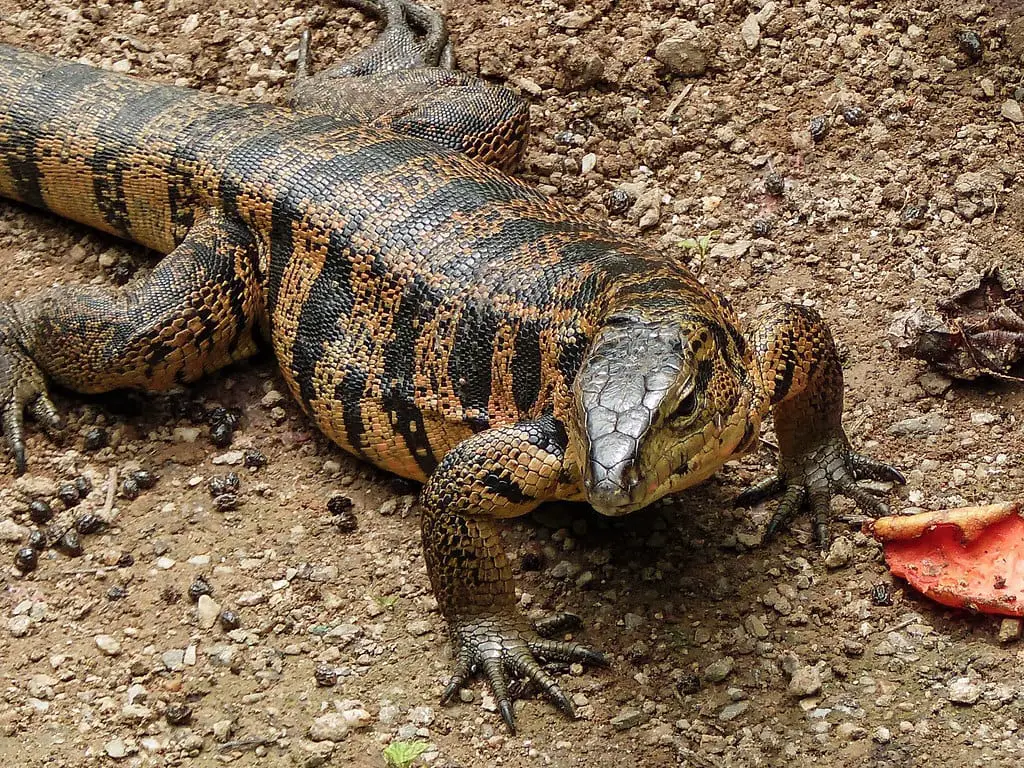
The Gold Tegu is also commonly referred to as Colombian tegu, common tegu, golden tegu, black tegu, and tiger lizard.
Not to be confused with the Argentinian black and white tegu, the gold tegu originates from Columbia, South America.
These agile, powerful lizards are known to attain an average size of 2 – 3 ½ ft., although there are recorded cases of these reptiles reaching 4ft. in length.
Exhibiting a very similar black and white body coloration like their relatives – the Argentine black and white tegus – gold tegus do actually grow smaller in size as compared to Argentine tegus.
Also, as compared to the skin of Argentine species, the skin of Tupinambis teguixin has a visibly smoother, glossy texture.
The most noticeable difference between Argentine black and white tegus and golden tegus is the scale located between the nostril and the eyes, aka the loreal scale. In Golden tegus, there is only one single loreal scale vs. two loreal scales in Argentine black and white tegus.
Golden tegus are characterized by strong limbs and fairly thick tails. The body coloration is marked by many gold and black stripes, giving these lizards an especially mesmerizing appeal.
Types
It was back in 2012 when taxonomical changes occurred with tegus, resulting in a number of these lizards being reclassified from genus Tupinambis to genus Salvator.
The Argentine black and white tegu is scientifically known as Salvator merianae. The Argentine red tegu is scientifically known as Salvator rufescens, and it originates from Paraguay and the northern parts of Argentina.
The yellow tegu (Salvator duseni) is native to Brazil.
The gold tegu belongs to the family Teiidae, genus Tupinambis. Male Colombian tegus are larger than females.
Habitat & Lifespan
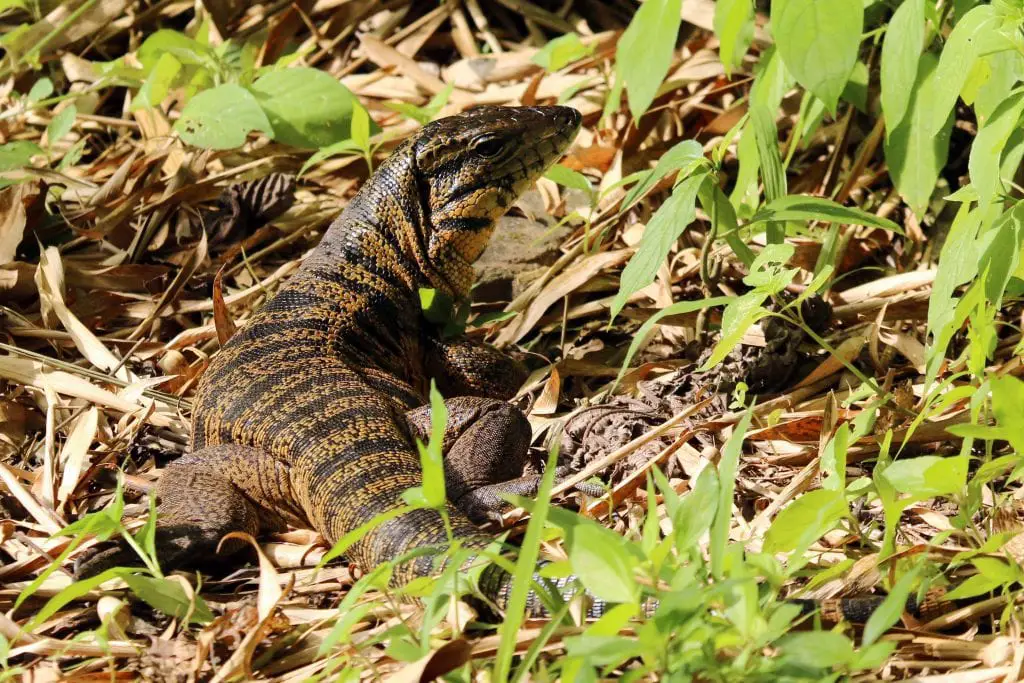
Just as one of their common names (Colombian tegus) suggests, gold tegus originate from the South American country of Colombia. However, these lizards can be also found throughout the Amazon basin, as well as in Panama.
The native habitat of golden tegus is tropical, being quite humid and high, as these reptiles live near the equator. They prefer open areas surrounding forests, but they may sometimes occupy secondary growth near agriculture, as well.
Being scavengers by nature, in the wild, these lizards can be also spotted farther south of the equator.
In captivity, gold tegus are known to live for between 12 – 20 years.
Behavior
Gold tegus have earned a solid reputation for being quite aggressive. This is only partially true, though, as these lizards’ aggression is actually a behavior that has helped them survive in their natural habitat in the wild.
They do tend to be much more territorial and defensive, as compared to other tegus. They truly dislike having their personal space being bothered, and will not hesitate to attack and bite in order to regain it by getting rid of potential intruders.
Also, following their instincts, gold tegus are known to be ruthless predators. They will actively chase down their prey, consisting of various animals they can overpower, using their dagger-like teeth to grasp the prey in their intimidating, strong jaws.
However, with the proper attitude and loads of patience, gold tegus’ naturally aggressive behavior can be tamed down. As long as proper care and loads of patience and understanding are applied by the caregiver, these lizard pets will enjoy spending time with their owner, allowing to be handled without any signs of aggression.
Even though they are capable of climbing, these terrestrial reptiles spend most (if not all) of their time on the ground.
Although too little is known about the behavior of wild Colombian tegus in general, which is also the case with their breeding habits, they are reported to regularly burrow their bodies into the soil for the purpose of cooling off.
Caging
As a rule of thumb, gold tegus require a fairly large enclosure in order to thrive. The larger enclosure you can provide, the better, as these big-sized lizards greatly depend on having enough space to be able to move about freely, eat comfortably, as well as to burrow when desired.
Embracing a DIY attitude to constructing a suitable enclosure for a Colombian tegu can be an excellent move. Caregivers can take advantage of various supplies widely available at home improvement stores. Also, a small spare room or a closet can be utilized successfully, and nonetheless, commercial-grade, large terrariums, will certainly work great, too.
The absolute minimum for an enclosure suitable to house a single adult gold tegu is 6 x 3 x 3 feet. Do mind that allowing the lizard to exercise outside of the enclosure is also strongly recommended to ensure the reptile’s health and well-being by letting the animal engage in physical activity, as this cannot be achieved if the caregiver is to solely rely on the free space available inside a 6x3x3ft. cage.
As gold tegus will rarely (if ever) climb, note that the floor space is much more important for them than the height of the enclosure is.
A baby Colombian tegu should be started in a tank that measures at least 36″ x 18″. When the baby tegu is to outgrow its enclosure, the caregiver can switch to an intermediate size 90 galloon cage. However, for fully grown adults, remember that you need to ensure an enclosure that is not smaller than 6′ x 3′.
Make sure to secure the enclosure well because these lizards are really powerful, and they adore to dig.
As a general rule of thumb, a gold tegu’s enclosure must be at least ½ the size of the lizard (including the tail).
In the basking area inside the enclosure, provide something suitable for the gold tegu to climb, for example, a shelf or a branch, so that the lizard will be able to get closer to the heating elements as desired.
The caregiver must provide at least one hiding area, yet better yet, provide two or three if possible. Suitable hiding places include commercial-grade reptile hides, or even something as simple as a strategically positioned, appropriately-shaped pieces of driftwood. For a nighttime retreat needed to make these reptiles feel safe while sleeping, it is best to provide a shelter made out of wood or stone.
To encourage your gold tegu to explore its enclosure, as well as to stimulate the reptile mentally, and nonetheless, to observe the lizard’s curious behavior, move things in the enclosure regularly, as long as you do not make the animal feel nervous, and in return, aggressive, while you are entering its personal space as to move the items from point A to point B.
To decorate the enclosure properly, make sure to use logs and/or heavy rocks, among other possible decorations, that are heavy enough as not to allow the Gold Tegu to rearrange them while exploring.
Substrate
Provide a deep layer of organic soil that is safe for reptiles in order to allow the gold tegu to burrow. Bark substrate can also work great. Mulch is also an excellent option.
The key point when choosing a substrate is to remember that the substrate has to be able to hold moisture well.
To aid in cleaning, utilizing large plastic containers is recommended so that the substrate can be easily and quickly changed without much of a fuss.
Temperature, Lighting & Humidity
- As a rule of thumb, God tegus come from a tropical environment, so it is the caregiver’s responsibility to provide his/her lizard pet with proper exposure to both UVB light and heat. For this purpose, a combination of basking lights, heat emitters, and full-spectrum, high UVB output lighting should be utilized.
- In the basking area, the temperature has to be maintained within the 90 and up to 110 degrees Fahrenheit.
- Keep the temperature within the rest of the enclosure within the 78 – 85 Fahrenheit range.
- During the night, allow the temperatures to drop down to no less than 75 – 70 degrees Fahrenheit.
- When placing UVB lighting, the caregiver needs to make sure not to position the lights on plexiglass or glass, since both of these surfaces block the invisible, much-needed rays, thus, compromising the lizard’s health and well-being.
- In the basking area, place the light bulb at a distance of approximately 12 inches. Do not forget that the bulb has to be replaced every 6 months, or as otherwise stated based on the recommendations on the package.
- Keep the white light-emitting lights ON for 12 hours vs. OFF for 12 hours in order to allow the Colombian tegu to have a proper day-night cycle. The UVB light has to be switched ON for 12 and up to 14 hours a day.
- To heat the tegu’s enclosure at night, use a night heat light-emitting either red or purple glow. Alternatively, ceramic heat emitters also make a wonderful option.
- By providing a large water dish for the gold tegu to drink and soak, you will be able to slightly raise humidity levels within the terrarium, thanks to water gradually evaporating from the water dish. However, since these lizards come from tropical environments, misting the enclosure on a daily basis, several times a day, is required to keep humidity levels between 60% – 80%.
Important Notes
Since maintaining the high humidity needed for captive Gold tegus to thrive high at all times tends to be quite challenging, the caregiver can consider further adding a humid hide by placing some nice wet moss inside. Also, although hand misters can work great, automatic misters are definitely a much more convenient and reliable way to maintain proper humidity at all times.
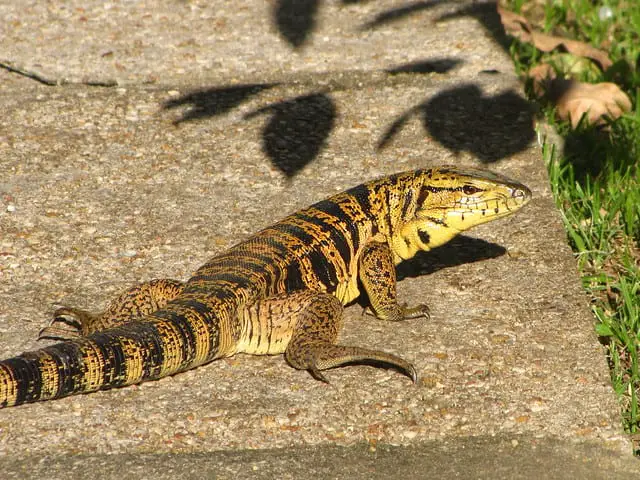
Diet
In the wild, gold tegus’ diet consists of various insects, small mammals, invertebrates, small mammals, birds, and reptiles. Sometimes, gold tegus will also feed on fish and fruit, as well.
Eating Habits
- For feeding smaller, young gold tegus, the caregiver wants to offer gut-loaded mealworms, wax worms, hornworms, cockroaches, and crickets, as all of these food items make a wonderful addition to some fruit. If you want to prevent the lizard from making a mess while feeding, you can place prey items in a suitably-sized plastic storage container, and then put the tegu within the container to allow it to eat.
- Feed young gold tegus every day.
- For smaller, young Colombian tegus and larger adults alike, dusting food items with vitamin D3 and calcium supplements at least every other day (better yet every day) is a must. Twice a week, provide a multivitamin supplement, as well, skipping on the calcium supplement the day you are to provide the multivitamin.
- Larger, full-grown gold tegus typically lose interest in insects. It is best to feed adults with pinkie mice, eventually transitioning to adult mice and rats.
- Feed adults every other day.
- As a rule of thumb, remember that the key to establishing a proper feeding routine gold tegus, just like with most reptiles kept as pets, is variety. Do not offer the same food to your tegu every single day. A varied diet should include about 80% high-quality sources of protein, and about 20% fruits and veggies.
- Suitable sources of protein for gold tegus include live insects, canned insects, shrimp, scrambled or hard-boiled eggs, cooked ground turkey, cooked chicken, snails, cooked lean ground beef, cooked beef heart, cooked chicken organ meats, appropriately-sized mice, whether frozen and thawed or live.
- Reserve eggs and poultry as treats for a varied diet, but not as a major part of the diet.
- Suitable fruits and veggies to feed to your gold tegu include strawberries, blueberries, figs, raspberries, mango, pumpkin, kiwi, melon, grapes, cantaloupe, pear, apples, papaya, apricots, squashes, and peas. You can also feed bananas, but make sure to only do so in moderation.
- You will know that the gold tegu has been fed well when the reptile’s belly becomes visibly rounded shortly after eating.
- Gold tegus can be fed both insides, as well as outside of the enclosure. However, do keep in mind that some experts recommend feeding gold tegus outside the enclosure, rather than inside that the lizard will not end up associating the caregiver with mealtime.
- It is a must not to hand feed your Colombian tegu, since if the lizard pet is to start associating your hand with food, it can be almost impossible to get the reptile well-used to being handled without trying to bite you. Just put the food on a suitable dish or plate instead.
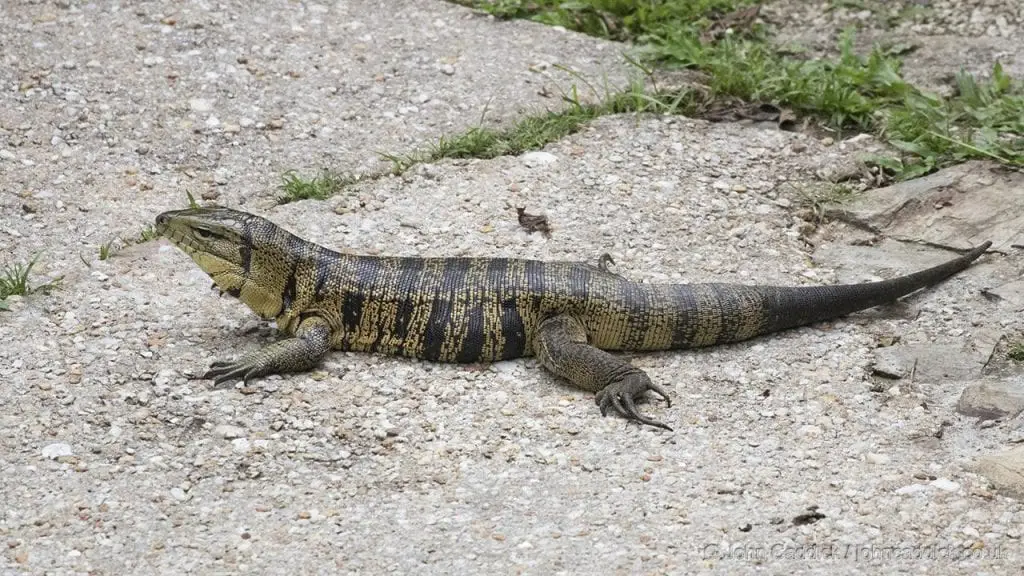
Sleeping Habits
Unlike the case with Gold tegus’ Argentine relatives – the Argentine tegus – captive gold tegus do not need to be bromated. Since Colombian tegus originate from a consistently warm, tropical climate, they do not hibernate in the wild.
Also, these creatures are diurnal, actively scavenging for food and basking throughout the day, while restfully sleeping at night.
Water
A non-porous water dish filled with clean, freshwater has to be available at all times. Apart from drinking water every day, tegus will also regularly soak in their water dish, so make sure to choose one that is large enough in size to allow the gold tegu to soak fully whenever desired.
Development and Reproduction
Nowadays, there is still too little information available when it comes to the breeding, development, and reproduction of Gold tegus.
However, based on the data available up-to-date, Gold tegus are known to reach adult size within only 3 years, with males typically grow up to 3 – 3 ½ feet, while females grow smaller, up to about 2 – 2 ½ feet. Males become sexually mature between 18 and 36 months of age.
Based on what researchers have managed to learn so far, the mating season occurs from May to June. Females lay their eggs, varying from 20 and up to 50 in number, from August and up to mind-September.
Born in burrows, the young gold tegus are usually left without any parental presence.
Even though these lizards do not necessarily hibernate in the wild, they may sometimes do so, ending up hibernating for up to 5 months, with hibernation believed to trigger breeding behaviors, as copulation was recorded to usually occur in about 1-2 months after the period of hibernation. If the female gold tegus do not hibernate, they are capable of another brood throughout the year.
How to Breed
Breed these amazing reptiles in captivity is a practice that should only be executed by experienced, advanced herpetoculturists, possessing an extremely in-depth understanding of these unusual, unique lizards.
Handling
In order to tame Gold tegus pets, proper handling that starts while these lizards are still hatchlings has to be applied with the utmost respect for the reptiles. Patience is crucial since these lizards cannot be tamed quickly, but rather than this, the process is a time- and effort-consuming one.
When starting to tame a Colombian tegu, the caregiver must not make any sudden moves or stare directly into the lizard’s eyes, to poke it or grab it forcefully, as this can frighten the reptile and make it defend itself in return.
Talk to the gold tegu very softly, being respectful towards its personal space and current mood. Be gentle and calm at all times. Remember, patience is key.
At the very beginning, it is best not to attempt handling the tegu, but instead, just let it roam in a small room, for instance, the bathroom, while you are keeping the lizard company, allowing it to relax in your presence. Just sit in the same room and gain its trust without any sharp moves or forced handling attempts.
As the gold tegu gets calmer in the caregiver’s company, the lizard will start crawling onto the keeper, thanks to stopping to perceive the keeper as any possible threat over time. The keeper should proceed with the no-handling bond strengthening practices to promote long-term bonding.
When gold tegus get larger and older, as well as much more lethargic, having spent plenty of time in the caregiver’s company without ever feeling threatened, the gold tegu may not only allow being handled, but it may even allow being taken for a walk on a leash just like a dog.
Please, mind that these large lizards have built a solid reputation as much more aggressive reptiles than their Argentine cousins, the Argentine black and white tegus.
Bonding with your gold tegu has to start from a young age, and the animal must be patiently given the time to become more content to hang around the keeper until, at some point, it will allow being carried around. However, if the caregiver does not practice patient bonding with the gold tegu from an early age, the reptile can remain quite hostile and aggressive towards humans, and handling may not be possible even when the tegu gets older and generally calmer.
Not the least, do keep in mind that the gold tegu tends to be a one-owner lizard pet, meaning that once the tegu starts trusting the caregiver, it will usually be only the caregiver whom the reptile will ever trust. It is possible for the lizard to allow other people to handle it, but only if these people have managed to build much-needed trust with this amazing lizard over time.
Ultimately, do not lose your good spirit if a young Gold tegu seems to keep acting aggressively, being seemingly untamable. The lizard is simply defending its territory, which is quite normal behavior, so watching you approaching just to try to grab it and/or poke it is definitely not going to help to earn the reptile’s trust. Forced holding and petting will only make things worse. As long as the enclosure is set up correctly, and food and water are provided, handling is only a matter of time (think of years, and not weeks or months).
How to Treat and Prevent Possible Health Issues
If a gold tegu refuses to eat, shows signs of dry skin and/or swelling, or if the tegu seems lethargic, the lizard pet must be immediately checkup by a qualified vet, as all of these are sure signs of a sick tegu.
Gold tegus, similarly to other tegus, are susceptible to respiratory infections, parasitic infections, and in severe cases, metabolic bone disease. By dusting insects with calcium and vitamin D3 supplements, and in conjunction with proper exposure to UVB light, the metabolic bone disease will be avoided.
Mind that calcium and phosphorus deficiencies are especially common, yet it is the caregiver’s responsibility to provide a proper, varied diet, calcium, and vitamin supplement, and nonetheless, ensuring that UVB lighting is functioning effectively. Most of the health issues listed above are fully avoidable if the enclosure is set up correctly, and the temperature, lighting, and humidity are kept within the optimal rates.
Please, note that you only want to sprinkle calcium powder on insects and vegetables very lightly. Also, no additional supplementation is needed when feeding rodents.
During shedding, it is best to monitor the gold tegu closely, misting the enclosure carefully to increase humidity. If any shedding issues occur, then this is an indication that humidity levels within the enclosure are not as high as needed. If the keeper does not react adequately, as a result of the dry shed, dry skin can lead to the loss of toes.
Apart from causing shedding problems, cages that are kept too dry can lead to dehydration.
Gold tegus are also prone to obesity, and obesity will affect their well-being and longevity adversely. Therefore, once they are fully grown, their weight should be monitored carefully, and they should be provided enough room and time to exercise.
Possible Dangers to Humans
Although Gold tegus are non-venomous, and hence, their bites will not lead to lethal consequences in humans, their powerful jaws and sharp teeth can cause some quite nasty wounds.
Do not leave children unattended with a Colombian tegu. Always be careful and respectful when interacting with the lizard pet. In the case of being bitten, immediately disinfect the wounded spot, and if needed, depending on the severity of the wound, consult with a qualified physician.
Although very rare, it is possible for Salmonella bacteria present in reptiles, Gold tegus included, to spread to humans. If ingested, Salmonella bacteria can cause serious illness in humans, yet it usually does not cause any illness in reptiles and amphibians alike. Always wash your hands thoroughly after cleaning the Gold tegu’s feces, as well as every time after interacting with the lizard pet to limit any chances of getting contaminated with Salmonella bacteria.
Availability: How to Get a Gold Tegu?
In the best-case scenario, one will be able to acquire a Gold Tegu from a reputable private breeder, keeping in mind that most of the gold tegus available in the pet trade as of now are mostly wild-caught animals since captive breeding is still rather limited in scope when it comes to these incredible lizards.
Fun Facts
It is fully possible to teach a tegu, Gold tegus included, to come to you when called by name, as these lizards are extremely intelligent!
As a group of researchers were into the task of compiling data about the behavior of Gold tegus in the wild, they came across a quite unusual discovery. When foraging for food, provided the Gold tegu is to see animal feces, the lizard is to literally take a head start, diving straight into the feces, fully rolling its body.
Although not much is known about this behavior as of now, the researchers have assumed that gold tegus are attracted to animal feces either because of the smell or because of possibly searching for insects.
Just like other tegus, Colombian tegus are known to forage by using their flicking, forked tongues as mighty chemoreception tools. Not the least, these lizards also go through ground cover and leaf litter by digging it up, hunting for sweet treats like termites and ants.
Gold tegus’ prey size usually correlates to their body size.
In the wild, it is often the case that the home ranges of males may overlap, which leads to severe completion for a mate during the breeding season. The male gold tegu is to follow a receptive female, carefully guarding her against any other males that may approach, as they are potential competition.
In some parts of northern South America, female Gold tegus have been observed climbing a tree’s trunk, just to dig a cavity in the termites’ nests, so that the female lizard can deposit her eggs in the termites’ nests! Afterward, the arboreal termites are to repair their nests while the gold tegu’s eggs are inside. This way, the eggs end up superbly well-protected from predators, while the repaired nest is much more humid and warmer, speeding up eggs’ development.
It is then during rains when eggs are to hatch, thanks to the termites’ nest being softened by water absorption until finally, the hatchlings emerge in their full glory.
Ultimately, the hatchlings will then feed on termites, thus, having plenty of food to thrive and develop properly, remaining in the trees after being born, far away from most predators.
If cornered, Gold tegus become extremely aggressive, they will bite and whiptail ferociously. Also, being extremely territorial, males are known to fight until death.
Equipped with fracture planes, Gold tegus are capable of successfully getting away from predators by breaking parts of the tail. By getting parts of their tail broken, gold tegus actually distract predators, thus, having enough time to escape.
How to Take Care of a Gold Tegu
It is true that many Gold tegus fail to become as tame as the puppy-like Argentine tegus. However, the level of docility a gold tegu can reach greatly depends on the keeper. If plenty of patience, respect, and persistence are applied, a Colombian tegu may be tamed down to the point of enjoying naps on the couch right alongside the caregiver, much like a cat would typically do!
In order to take the best care of Gold tegus, always remember that these lizards are extremely smart and very active. Provide them as much space to exercise, roam, and explore as possible, and avoid making the error of giving them less room than needed, so that ultimately, both you, as well as your Gold tegu, will be much happier together.
Colombian tegus are known to sometimes confuse fingers for potential tasty snacks, especially as these lizards are very quick when it comes to pouncing on small, moving objects, so act accordingly to avoid being bitten!
Mind that nervous specimen, which is often the case with new imports rather than captive-bred ones, are known to occasionally lash out with their giant bullwhip-like tail, scratch, and bite. However, this is rarely the case with well-fed, properly taken care of, older Gold tegus, as they become significantly heavy-bodied, much calmer than young ones, and nonetheless, much more lethargic, inflicting any possible nasty scratches, bites, or whiptails very rarely, and being much more easy to manage in general.
You cannot take good care of a Gold tegu in the absence of a quality thermometer and hygrometer within the enclosure. Ideally, place a thermometer on each end of the enclosure, making sure to secure each thermometer in place, so that the tegu will not be able to move it while exploring its environment. Also, set up the enclosure, including decorations, heating, and lighting equipment, at least 1 week prior to acquiring a gold tegu, so that you will be able to possibly make necessary adjustments without exposing your lizard pet to any health and well-being risks.
Scrub the water bowl every several days (at least once every week!), as to prevent bacteria slime buildup. Also, be prepared to change the water daily, especially if the tegu is to kick bedding into it and/or defecate.
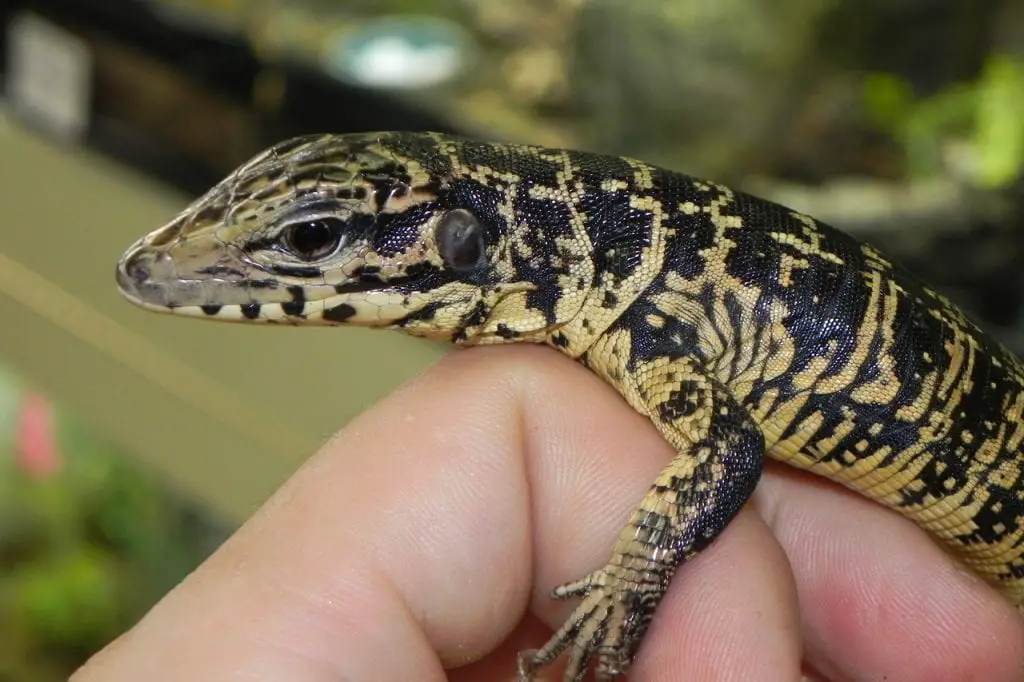
FAQ Section
Are Gold Tegus Aggressive?
Gold tegus have the reputation of being quite aggressive reptiles by nature, and while this is true, tamed Gold tegus kept as pets are highly unlikely to show signs of aggression, such as inflicting their notoriously nasty bites.
Are Gold Tegus Intelligent?
Gold tegus are impressively intelligent animals, and in fact, these lizards can even be house-broken. Provided with proper care and respect, Gold tegus can become very well acclimated to their keeper, fully capable of becoming quite docile as they mature into adulthood.
Are Gold Tegus Bites Dangerous?
Gold tegus’ bites can be quite painful since these lizards’ biting force can equal up to 1 000 newtons (for large adult specimens), which is enough to mess up the human flesh very seriously and is upward the average large dog’s biting force. However, even though gold tegus can bite dangerously, tamed ones are highly unlikely to do so.
Do Gold Tegus Eat Cats?
No, Gold tegus do not eat cats, and neither do they eat dogs. However, gold tegus may enjoy snacking on cat or dog food.
Do Gold Tegus Make Good Pets?
Whether a gold tegu will make a good pet or not is strictly a matter of personal choice and personal perspective. For the caregivers who are willing to put in the time, patience, and efforts to take the best care of a Gold tegu pet, these inquisitive, unique lizards can turn into best friends for years to come.
What to Feed a Gold Tegu?
Feed baby gold tegus a variety of gut-loaded insects dusted with calcium powder. Feed adults different sources of quality protein, such as rodents, shrimp, and cooked lean meat, among others, occasionally providing fruits and other treats, such as boiled eggs.
How Often to Feed a Gold Tegu?
Feed hatchlings on a daily basis up until the point when they reach maturity as they turn about 3 years old. Feed sub-adult gold tegus every other day, and lower the feeding frequency to about 2 – 4 times a week for large adults, providing as much food as to notice the belly being rounded after the feeding, regardless of age.
Do Gold Tegus Stink?
No, Gold tegus, similar to other tegus, do not stink. However, Gold tegus’ feces certainly smell bad, but with regular cleaning and by using appropriate tools, the smell should not be an issue.
Can Gold Tegus Swim?
Like other fast-moving Tupinambis lizard species, Gold tegus can swim very well, and they will rarely hesitate to cross water. However, they are terrestrial creatures, preferring to spend the majority of their time on the ground rather than in water.
How Long Do Gold Tegus Live?
Being the smallest species of tegu, Gold tegus are known to live for approximately 15 years, and to be more precise, they usually live for 12 – 20 years in captivity, as long as they are provided proper care.
Can You Tame a Gold Tegu?
Gold tegus are known supplements more aggressive and harder to tame than the Argentine species, and that’s why they are typically not recommended for children and newbie reptile owners alike. However, with time and patience, Gold tegus can be tamed, and even though they will rarely become as tolerant to handling as the Argentine black and white tegu, they can certainly make fantastic, fairly docile pets for the advanced reptile enthusiasts willing to put in the needed time and efforts to tame them.

